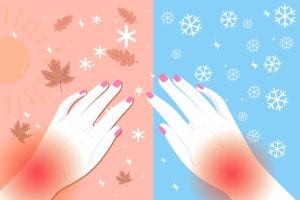

If it hasn’t arrived where you live yet, rest assured that winter is coming — and that can be bad news for people with arthritis (both inflammatory arthritis and osteoarthritis), many of whom can literally feel the season in their bones. “Some people with arthritis feel better in the winter, but most feel worse,” reports Vinicius Domingues, MD, a rheumatologist in Daytona Beach, Florida, and medical advisor for CreakyJoints.
Science hasn’t homed in on the reason that cold weather can exacerbate arthritis joint pain and stiffness, but there are a few possible explanations. A fall in barometric pressure, which often occurs as a cold front approaches, can cause joints to expand, which may result in pain. Low temps may also increase the thickness of the synovial fluid that acts as the joint’s shock absorber, which makes joints stiffer and more sensitive to pain. Winter even seems to affect us down to our DNA. According to one 2015 study, genes that promote inflammation are increased in winter, while genes that suppress inflammation are simultaneously decreased in the winter. If all that’s not enough, flu season is also riskier when you have inflammatory arthritis.
The good news: Winter doesn’t have to be season of your discontent if you have arthritis. Check out this advice on how to stay healthy and manage your arthritis pain during the winter months.
Tips to Cope with Arthritis in Cold Weather
1. Stay active
Exercise is crucial for people living with arthritis, according to Benjamin Nowell, PhD, director of patient-centered research for CreakyJoints. Physical activity helps ease pain, increase strength and flexibility, and boost energy. Avoiding exercise because you’re worried it can make your arthritis worse is a big misconception. In fact, adults with arthritis who have normal physical function and no other severe health conditions are advised to do at least 150 minutes of moderate-intensity aerobic activity a week, as well as two weekly sessions of strength training.
Not surprisingly though, people tend to move less in winter. And many people with arthritis have significant pain and fatigue, which makes exercise challenging to begin with. On days when the very thought of exercise seems unbearable, these gentle range-of-motion exercises can be helpful.
If snow and ice have made the streets and sidewalks too risky to walk on — and this is especially true if arthritis has caused you to have balance issues — try mall walking, doing workout videos online (YouTube has tons of options), or using a workout app like Aaptiv. Or consider a gym membership. Talk to the fitness director to explain your goals and challenges and determine your best course of action — be it yoga, tai chi, swimming, or a low-impact group exercise class.
Another tip: Find an exercise buddy, possibly another person who faces similar health challenges. People tend to be more inclined to try a new form of exercise if they attend with a friend.
2. Get your yearly flu shot — and stay current on your pneumonia vaccine
Even the healthiest people can be felled by the flu, but those with rheumatoid arthritis (RA), psoriatic arthritis, ankylosing spondylitis, and other autoimmune forms of arthritis are at even greater risk of infections like the flu and pneumonia. Both the arthritis itself, which compromises how well your body fights off infections, and certain medications used to control the disease, which can further weaken the immune system, can make flu season more risky — resulting in higher susceptibility of catching viruses, more severe infections and complications like pneumonia and hospitalization, and longer recovery periods.
While the Centers for Disease Control and Prevention (CDC) recommend getting a flu shot by October, since the flu typically occurs between October and May, it’s not too late to get vaccinated. People with inflammatory arthritis should get the inactivate vaccine (the flu shot), which contains killed viruses. The nasal spray vaccine contains live viruses that can weaken the immune system and is not currently approved for use in people with inflammatory arthritis.
If you have RA and take methotrexate, which is considered a first-line therapy for the disease, be aware that a recent study found that discontinuing the drug for two weeks after getting a flu shot resulted in a significantly stronger immune response — up to 20 percent better — without any increase in the flare rate. You can ask your doctor if that’s a good option for you. Here’s more info about the flu vaccine and inflammatory arthritis.
3. Keep warm
Heat is like a spring thaw for your stiff joints. It boosts blood flow to help flush out pain-producing chemicals and stimulates receptors in your skin that improve your pain tolerance. Warmth also relaxes muscles to decrease spasms and reduce stiffness.
There are many ways to reap the benefits of heat therapy: a warm shower or soak in a tub (dress warmly afterward to prolong the benefit), heating pads (opt for one that delivers moist heat, which penetrates more deeply than dry heat), electric blankets, and single-use hand and feet warmers that you can slip into your gloves, pockets, or shoes. Even wrapping your hands around a hot cup of coffee or tea and warming up the car before hitting the road can be helpful in your quest to quell joint pain.
4. Dress the part
Getting dressed when your arthritis is flaring can be an exhausting struggle, notes Dr. Nowell. Try dressing in layers, which can provide even more warmth than a single heavy item. A garment made of lightweight wool is a smart choice for the layer that’s next to your skin — it’s good at trapping warm, dry air so it will keep you toasty. A vest is also a wise investment: By insulating your core, warmer blood is continually sent out to the body’s extremities, which keeps them warmer. Opt for a fleece or down vest, which will keep you warm without adding a lot of weight. When buying outerwear, consider both functionality (such as ease of opening and clothing) and durability (weather protection). Despite keeping you warm and dry, bulky or heavy items can hinder ease of movement and even affect balance. These assistive devices can help make getting dressed easier.

5. Wear compression gloves
Donning accessories like hats, scarves, gloves, and boots is especially important, since the majority of heat is lost from the body’s extremities. You might want to try out a pair of thermal compression gloves. (Here’s more information on how arthritis gloves help improve symptoms.) They vary in style and technology, but some will emit or help trap heat to provide a warming sensation as well as provide compression to reduce swelling. Most styles are fingerless, so they’re not suitable for outdoors, unless you slip another pair of gloves or mittens on over them. If you don’t have a strong preference, mittens tend to be warmer than gloves because your fingers generate more heat when they’re not separated from each other by fabric, as they are with gloves.
6. Sidestep slips
Winter conditions can make it tricky to maintain your footing when you head outdoors, but there are some precautions you can take. For starters, select footwear that provides stability and traction. Before going out, be sure to bundle up — warm muscles are more relaxed, which can make it easier to keep your balance. Exercise caution on snowy stairs or sloped ground. Stay on cleared sidewalks and paths if possible. If you need more stability, consider a cane, walker, or even trekking poles to help keep you steady on your feet.
7. Avoid “D” deficiency
It can be difficult to get enough vitamin D in the winter. It’s produced when your bare skin is exposed to sunlight (that’s why it’s called the sunshine vitamin). And even though your body can store levels of vitamin D throughout the seasons, research shows people are often deficient in the winter. That can spell bad news for inflammatory arthritis patients, as studies show have shown that lower vitamin D levels correlate with more severe clinical manifestations of RA and other rheumatic diseases. Low vitamin D levels are also associated with sensitivity to pain. Vitamin D is one of a few supplements for arthritis doctors often recommend.
Men and women should aim for 600 IU a day (800 IU if you’re over age 70). Good dietary sources of vitamin D include fatty fish like swordfish, mackerel, salmon, and tuna, and fortified products like orange juice, milk, and breakfast cereals. If you can swallow it, 1 tablespoon of cod liver oil delivers a whopping 1,360 IU of vitamin D. Talk to your doctor about testing your levels of vitamin D to be sure you’re not deficient (some arthritis drugs can interfere with its absorption). If your vitamin D level is low, you may be advised to take a supplement.

8. Steer clear of people who are sick
“Use common sense and avoid people around you who are coughing or otherwise under the weather,” says Dr. Domingues. To stay safe at home, be sure others in your household get their flu shots and other recommended immunizations to prevent the spread of flu. If you’re under the weather, stay home from work or social activities to give yourself time to rest and recover.
Keep Reading
- Arthritis Flare-Ups: What Causes Them and Exactly What to Do When You Have One
- Convinced the Weather Affects Your Arthritis Joint Pain? Here’s What a New Study Says About It
- 22 Self-Care Tips for Arthritis to Give a Try





